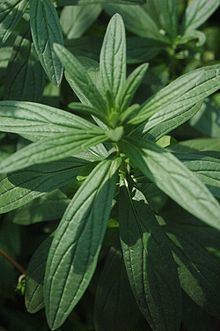Order (unplaced) Subfamily Boraginoideae Rank Species | ||
 | ||
Similar Lithospermum, Arnebia, Lithospermum purpurocaeruleum, Boraginaceae, Lithospermum officinale | ||
Lithospermum erythrorhizon
Lithospermum erythrorhizon, the purple gromwell, red-root gromwell, 紫草 zicao (Pinyin: zǐcǎo), 紫草 murasaki・sō (Japanese) is a plant species in the genus Lithospermum.
Contents
The dried root of Lithospermum erythrorhizon (lithospermum root or Lithospermi Radix, Kanji: 紫根, Katakana: シコン, Pinyin: zǐ gēn, Traditional Chinese: 紫根, Simplified Chinese: 紫根) is a Chinese herbal medicine with various antiviral and biological activities, including inhibition of human immunodeficiency virus type 1 (HIV-1).
Lithospermum erythrorhizon
Biochemistry
The enzyme 4-hydroxybenzoate geranyltransferase utilizes geranyl diphosphate and 4-hydroxybenzoate to produce 3-geranyl-4-hydroxybenzoate and diphosphate. Biosynthetically, alkannin is produced in plants from the intermediates 4-hydroxybenzoic acid and geranyl pyrophosphate. This enzyme is involved in shikonin biosynthesis.
The enzyme geranylhydroquinone 3''-hydroxylase uses geranylhydroquinone, NADPH, H+ and O2 to produce 3-hydroxygeranylhydroquinone, NADP+ and H2O.
Culture
It has been cultivated in Japan since the Nara period for its root, which can be used for herbal medicine and to make dyes.
One Japanese word for the plant, murasaki (紫), inspired the pen name "Lady Murasaki" for the author of The Tale of Genji and is also the source of the general Japanese term for the color purple, murasaki iro (紫色).
The dyes made from its root also had other names, such as shikon (紫根), but all of them were difficult to work with because of their requirement for an alum-rich mordant and the resulting colors' extreme vulnerability to photobleaching. During the Heian Period, sumptuary laws restricted murasaki-dyed clothing to the Empress and her ladies in waiting.
